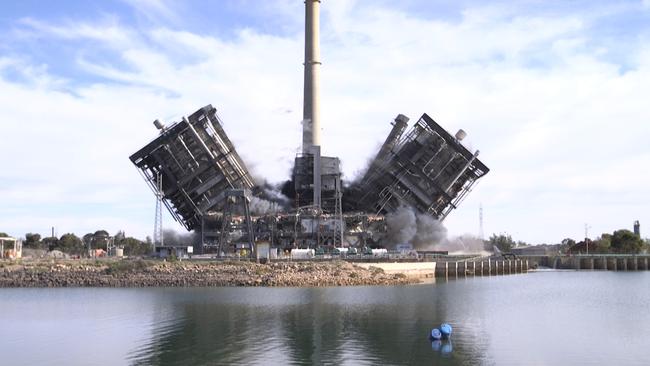Billions needed to shore up power for future
The new federal government has a massive task ahead to deliver reliable, low-emissions electricity — and try to stop Australia’s trajectory of higher power prices.
Federal Election
Don't miss out on the headlines from Federal Election. Followed categories will be added to My News.
Only one thing is really clear about the electricity system of the future — it won’t look anything like the system of the past.
The policies of whichever party forms government will be a crucial component to whether Australia continues on a trajectory of higher power prices or achieves the trifecta of affordable, reliable and low-emissions energy.
Ageing coal-fired power stations, increased large and small-scale renewable energy and gas-fired plants, state and international policies and the appetite for investment by the private sector add to the incredibly complex mix of forces impacting on the system.
The closest thing Australia has to a national roadmap has been developed by the Australian Energy Market Operator.
It says by 2040, one third of the energy now generated by coal-fired power stations will be gone as plants close after 50 years’ service.
Replacing this capacity will cost between $8 billion and $27 billion.
Whatever happens “this level of capital investment is going to be needed”, AEMO says in its Integrated System Plan.
The lowest cost pathway will be a portfolio of solar, wind and storage complemented by flexible gas plants and more transmission.
“Both in the context of emissions policy and due to their falling costs, renewable wind and solar resources are quickly becoming the lowest capital cost resource for supplying energy,” it says.
“Almost 80 per cent of all currently announced, proposed, advanced, or committed projects in the National Electricity Market are wind or solar generators.”
The market “is already on a path to wide-scale, fundamental transformation”.

The next federal government knows consumers are increasingly angry about power prices.
Less than a third of households believe the market is working in their long-term interest and small business owners rank electricity as worse in value-for-money than banking, insurance and internet services, according to surveys by Energy Consumers Australia.
In the capital cities since 2000, electricity prices have increased the most in Sydney followed by Melbourne and then Adelaide — with prices in all three cities doubling in addition to inflation increases according to the Australian Energy Regulator
It found that in 2018 customers on the most expensive electricity offers in Victoria, NSW and South Australia were paying more than double what customers on the cheapest offers paid per unit of electricity.
There have been multiple reports looking at the electricity market and suggesting reforms.
These include chief scientist Alan Finkel’s independent review and the Australian Competition and Consumer Commission’s Retail Electricity Pricing Inquiry.
The ACCC now reports every six months on progress on 56 recommendations it made to reduce prices.
Its first monitoring report published last month said there was still much work to be done but there was progress on transparency and pressure on retailers.
From July, retailers will have to compare discount offers against a default market offer for that state and cannot use misleading headlines about conditional discounts.
The Australian Energy Market Operator is currently consulting widely on its system plan ahead of an update.
From its consultation, three common themes emerged:
EMISSIONS reduction needs to be clearer.
THERE are a wide range of possible energy futures.
MODELLING of generator retirements needs to be based on more than technical retirement age
AEMO agrees it must look more deeply at coal-fired power stations because plant owners may retire them earlier if they are no longer making enough money.
The revision also will take more account of weather on demand and supply because of increased renewables “so the future system remains reliable and dispatchable in all hours, even when the wind is not blowing and the sun is not shining”.

AEMO is among many groups trying to model the future of emissions policy and the effects of climate change — with very varying results depending on assumptions they make.
University of Melbourne Professor Tom Kompas estimates a 2C increase in global temperatures will cost Australian gross domestic product $24 billion a year and 4C increase $117 billion a year to 2100.
BAEconomics managing director Brian Fisher estimates a GDP loss averaging $26 billion a year to 2030 under Coalition policies and $109 billion a year under Labor’s policies.
Companies most likely to make the investments needed — such as AGL and Origin — stress that the situation is extremely fluid and complex.
They warn of risks that government intervention and regulation can have unintended consequences of stifling investment and competition.
Separately, the Minerals Council of Australia has urged caution about coal.
The council “acknowledges that sustained global action is required to reduce the risks of human-induced climate change” but chief executive Tania Constable says there must be regard for the industry’s 50,000 workers and 120,000 indirect jobs.
Australia is not alone in addressing the challenges of transition.
Energy super major BP estimates coal contribution to total global energy consumption will reduce from 28 per cent in 2017 to 7 per cent in 2040 while renewables will increase from 4 per cent to 29 per cent under BP’s rapid transition model.
BP now has linked annual cash bonuses of about 36,000 employees — including chief executive Bob Dudley — to emissions-reduction policies.
Shell has a stated intention to be world leader in electricity and sees gas as companion to renewables.
Originally published as Billions needed to shore up power for future


